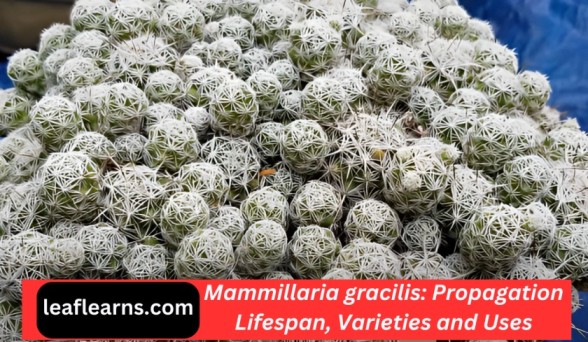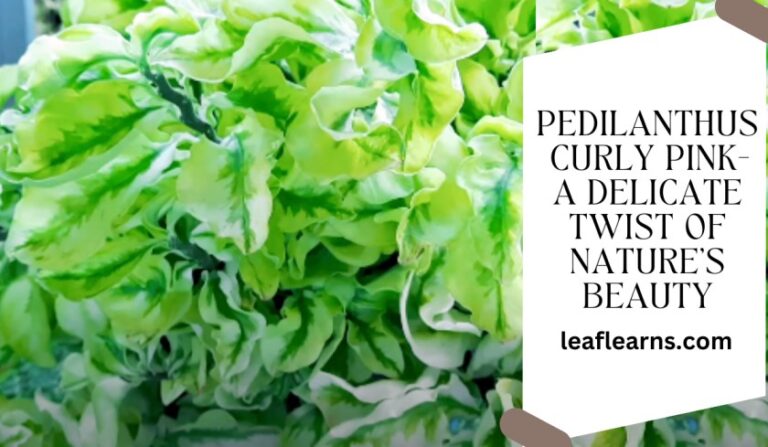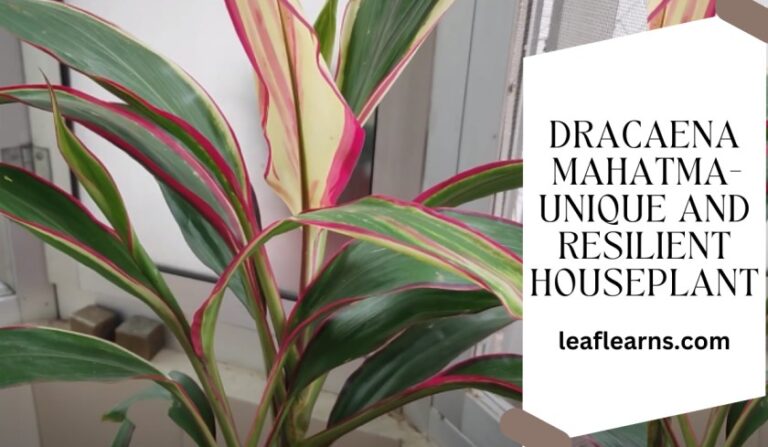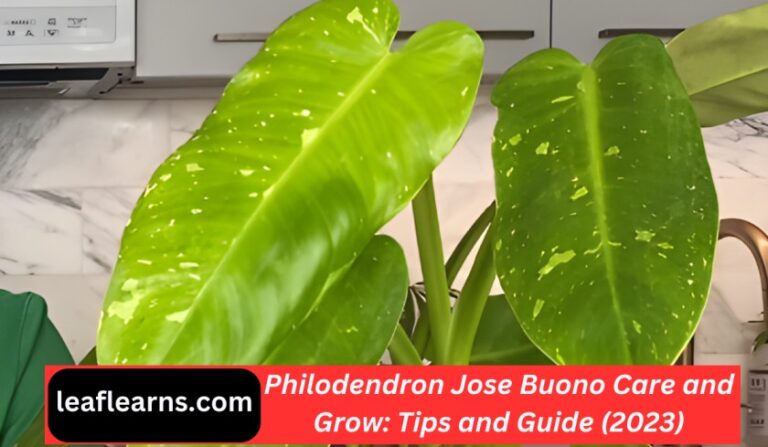How to Care and Propagation For Bird of Paradise: Guide (2023)
The Bird of Paradise plant scientifically called as Strelitzia spp, and its comes from South Africa and is a member of the Paradisaeidae family. It may grow up to 20 feet (5–6 meters) tall and has stunning blue-green tropical leaves. It is a tropical perennial.
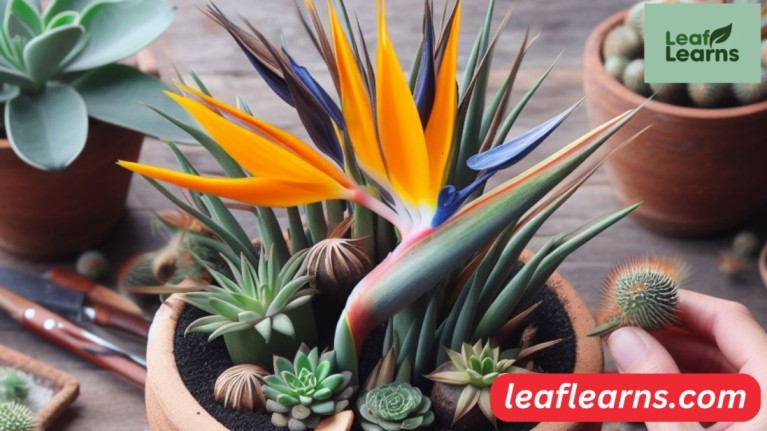
This plant needs moderate to high humidity levels and is at its best in temperatures between 50 and 72 °F (10 and 22 °C) outside and 65 to 70 °F (18 to 24 °C) inside. Pruning on a regular basis to remove wasted blooms and dead foliage is necessary to keep the plant looking alive.
The Bird of Paradise plant prefers well-draining potting soil and intense indirect light over full sun exposure when it comes to lighting. It requires moderate watering, with a small amount of soil drying time in between applications.
This plants may be multiplied by division, seeds, or rhizome cuttings and are distinguished by their striking orange, blue, or white blooms.
| Common name | Bird of-Paradise |
| Scientific Name | Strelitzia spp. |
| Family | Paradisaeidae |
| Distribution | South Africa |
| Plant type | Tropical Perennial |
| Size | 5-20 feet (1.5-6 meters) |
| Leaf Colour | Blue green tropical foliage |
| Leaf size | 3′- 8′ tall, |
| Temperature | 65-70°F (18-24°C) indoors; 50-72°F (10-22°C) outdoors |
| Humidity | Moderate to High |
| Pruning | Remove Dead Leaves and Flowers |
| Light requirement | Bright Indirect to Full Sun |
| Soil requirement | Well-Draining Potting Mix |
| Watering Need | Moderate; Allow Soil to Dry Slightly Between Watering |
| Pruning | Remove Dead Leaves and Flowers |
| Flower color | Vibrant Orange/Blue/White |
| Propagation | Division, Seeds, Rhizome Cuttings |
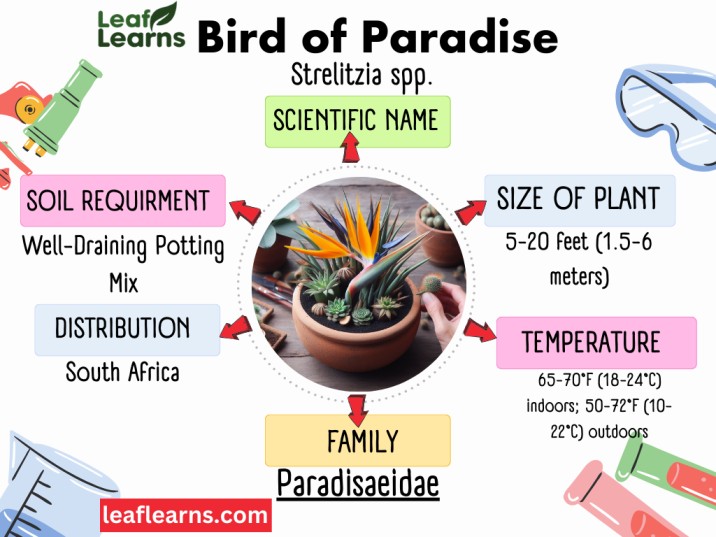
Contents
- 1 Top Care Tips
- 2 Care for Bird of Paradise
- 3 Propagating Bird of Paradise
- 4 How to Grow From Seed
- 5 Pruning
- 6 Growth Rate and Size
- 7 Repotting
- 8 Flowering and Foliage
- 9 Overwintering
- 10 Common Pests
- 11 Plant Diseases
- 12 How to Get Bloom
- 13 Problems and Solutions
- 14 Toxicity of Bird of Paradise
- 15 Pets
- 16 Bird of Paradise Appearance
- 17 Varieties/Types
- 18 Suggested Uses
- 19 Plant Care: Tips for Thriving Indoors and Outdoors
- 20 Ensuring Pet Safety: Bird-of Paradise Plants and Their Toxicity to Cats and Dogs
- 21 FAQs
Top Care Tips
- For optimum development and flowering, provide bright indirect to full sun exposure.
- Watering: During the growth season, keep the soil continuously moist, but let it become a little drier in between applications. Winter irrigation should be minimized.
- Maintain moderate to high levels of humidity, particularly if you’re growing it inside. Use a humidifier or frequently mist the leaves.
- Pruning: To promote new growth and keep it looking appealing, regularly remove wasted blossoms and dead leaves.
- Potting Mix: To avoid soggy roots and promote healthy development, plant in a potting mixture that drains well. When it outgrows its container, repot it.
Care for Bird of Paradise
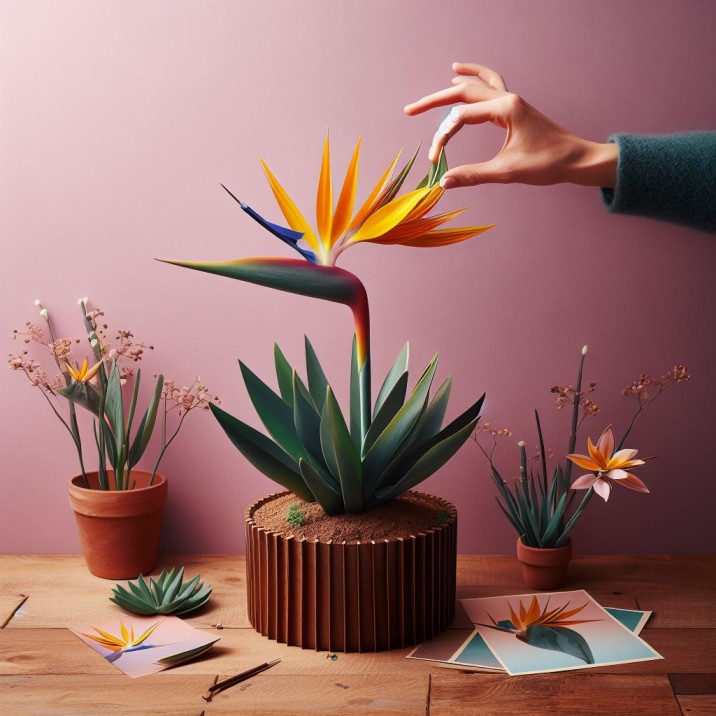
Light Requirement
To flourish, bird of-paradise plants require sufficient light. Put them in a location where they can receive a lot of indirect light or even some direct light.
Consider a bright, sunny area of your home where the plant isn’t directly exposed to the sun’s beams. They enjoy sunshine while outdoors, but not all-day heat.
They will develop healthily and yield lovely flowers if the proper lighting is provided. So, locate them a sunny area, and they will be content.
Water Requirements
For the health of your Bird-of Paradise, water it regularly. During the growth season, keep the soil regularly wet but don’t go overboard.
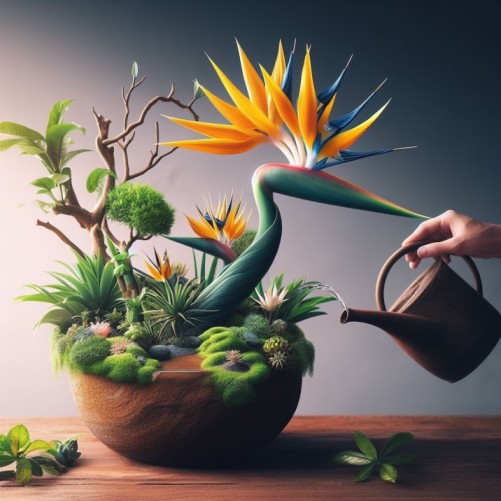
If the soil feels dry when your finger is inserted an inch into it, it’s time to water. Reduce watering throughout the winter since the plant requires less moisture.
Remember that between watering, This plant wants to somewhat dry out, so avoid keeping it wet. Watering your plant correctly promotes growth and prevents root rot.
Soil Requirement
Consider the soil needs of your plant while caring for it. Plants of the Bird of-Paradise flourish on soil that drains properly.
This implies that the roots shouldn’t be submerged in water by forcing surplus moisture to evaporate from the soil.
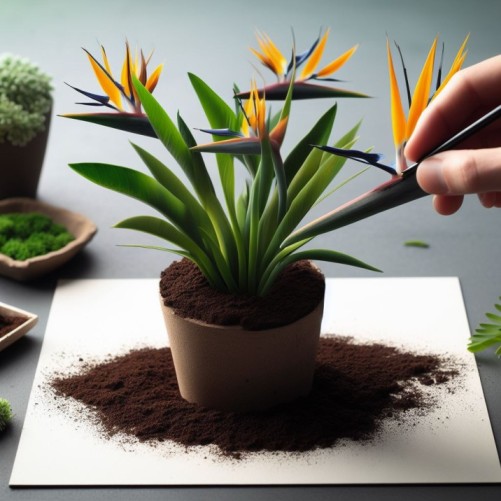
This may be accomplished by using a potting mix made specifically for tropical plants or by adding perlite to ordinary potting soil.
Your plant’s roots will remain healthy if the soil drainage is good, eliminating problems like root rot and encouraging luxuriant growth.
Temperature Requirement
When growing inside, bird-of paradise plants like temperatures between 65 and 70 degrees Fahrenheit (18 and 24 degrees Celsius) and outside, between 50 and 72 degrees Fahrenheit (10 and 22 degrees Celsius).
Just imagine the lovely weather you like, since that’s how they feel.
As a result, if it’s too hot or cold for you, it probably will be for your Bird of-Paradise. If you keep them warm, they’ll prosper.
Humidity Requirement
In order to flourish, this plants require a little level of humidity, or the amount of moisture in the air.
Imagine it as a tiny moisture hug for the plant! What you should do is: Sometimes, mist the leaves with water, or place a tray of water nearby.
This makes the plant more comfortable, especially if you reside somewhere arid.
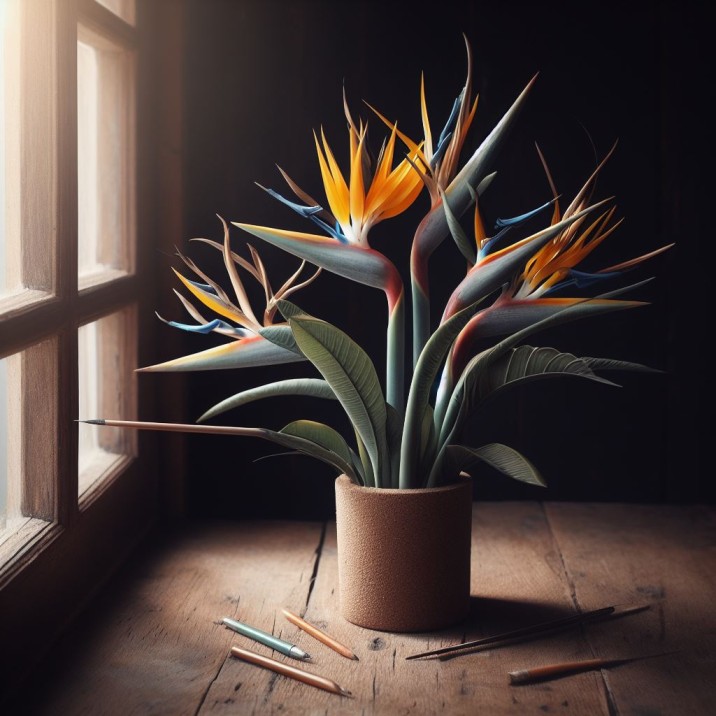
Fertilizer Requirement
Giving your Bird-of Paradise fertilizer is similar to feeding it a healthy meal. These plants benefit from a healthy, balanced diet.
You may feed them once a month with a balanced liquid fertilizer during the growing season, which is similar to their active period.
But you may reduce the feeding to perhaps once every two to three months while it is resting, which is like its downtime. Just keep in mind that they want moderation so don’t overfeed.
Consider it as giving them a small reward to maintain their well-being.
Potting Requirement
You must pay attention to your Bird of-Paradise’s potting requirements if you want to take good care of it.
These plants want to grow in soil that drains properly, so water shouldn’t pool around their roots.
Select a pot with drainage holes and fill it with a mixture that allows extra water to drain. This helps avoid root rot, a frequent problem.
Make sure the new pot isn’t too huge when you repot your bird plant since they like a little snug fit. Your plant will remain happy and healthy with proper potting!
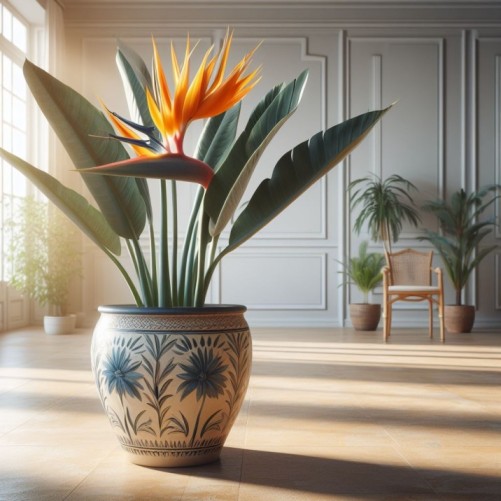
Propagating Bird of Paradise
Division
- The most popular and effective approach is this one.
- Wait until your plant’s base is sprouting multiple branches or shoots.
- Remove the plant from its container, then carefully remove the primary root system from these sprouts.
- A division should have both roots and branches.
- Repot each division into a separate, well-ventilated container.
- Place in an area with bright, indirect light after fully watering
Seeds
- From mature Bird of-paradise blooms, gather new seeds.
- To soften the seed coat, soak the seeds in warm water for a day.
- Place the seeds in a seed-starting mixture and lightly cover them.
- Keep the temperature at roughly 70–75°F (21–24°C) throughout the day.
- Make sure the soil is consistently wet but not soggy.
- It may take weeks or months for seeds to germinate.
Rhizome Cuttings
- When repotting a mature Bird-of Paradise, rhizome cuttings can be taken.
- Cut a portion of a healthy rhizome that has roots and branches.
- Give the cut end a day or two to dry up and develop a callus.
- Rhizome cutting should be planted in a fresh pot with a soil that drains effectively.
- Till new growth emerges, maintain a constant moisture level in the soil.
Offset Cuttings
- In order to use this technique, a cutting must be taken from an offset shoot, a tiny shoot growing next to the main stem.
- Using a tidy, sharp pair of scissors or a knife, trim the offset.
- Give the cut end a day to dry.
- Keep the offset cutting continually wet and plant it in a container with well-draining soil.
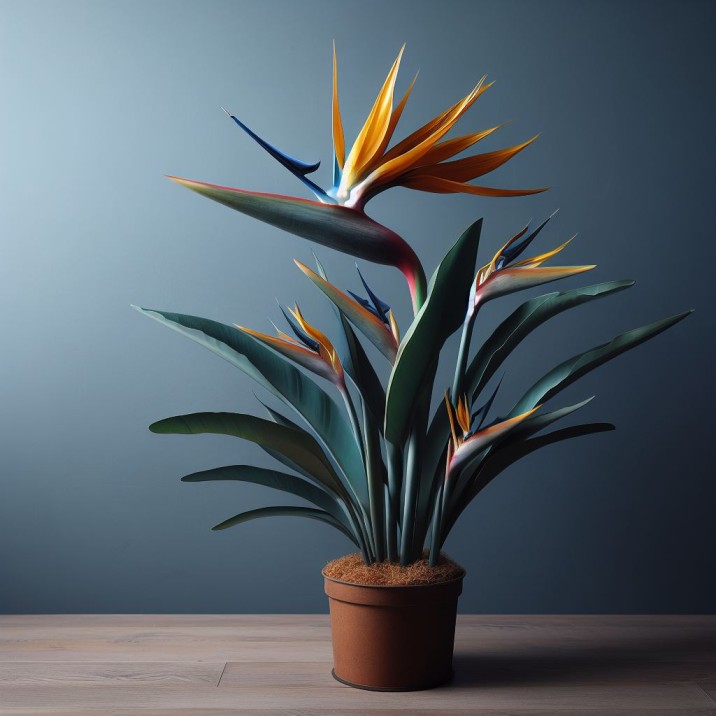
How to Grow From Seed
A pleasant experience is starting a Bird of-Paradise plant from seed. The seeds should first spend a day soaking in warm water.
Then, put them in a potting mixture that drains properly while keeping them wet. Keep the pot away from direct sunlight and in a warm, sunny location.
Be patient; germination might take some time. Transplant them into bigger pots after they have sprouted.
Pruning
Giving your Bird plant a trim is similar to pruning it. Trim away any damaged or dead foliage as well as any faded blooms.
The plant will appear tidy and healthy as a result. Snip these away with fresh scissors or pruning shears.
Keep in mind that being gentle is crucial to avoid damaging the good portions. By trimming, you promote new growth and maintain your Bird of -paradise’s finest appearance.
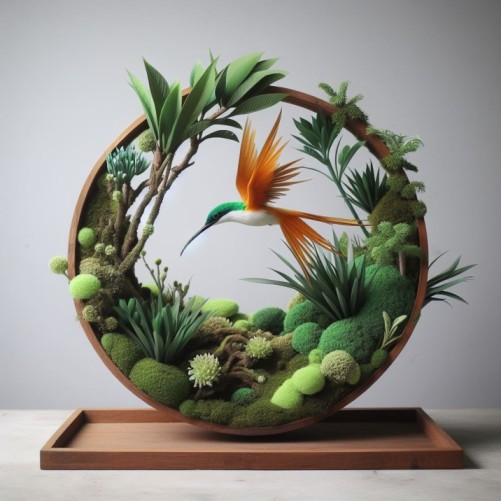
Growth Rate and Size
Bird of-Paradise plants grow at a moderate rate and eventually get pretty tall. They generally stand between 5 and 20 feet (1.5 and 6 meters) tall.
Think of them as dependable, slow-growing plants that, with the right care, may develop into stunning, tropical beauty for your environment.
Remember that depending on the exact variety and environmental factors, their size may vary, therefore some time is required to realize their full development potential.
Repotting
When your Bird-of Paradise outgrows its present pot, you must repot it by transplanting it to a bigger one.
To accomplish this, carefully detach the plant from its current container and set it in a new, somewhat bigger one with fresh potting soil.
This aids in the plant’s root development and improved growth. Normally, you should repot every two to three years.
It’s similar to giving your plant extra space to spread its wings and grow!
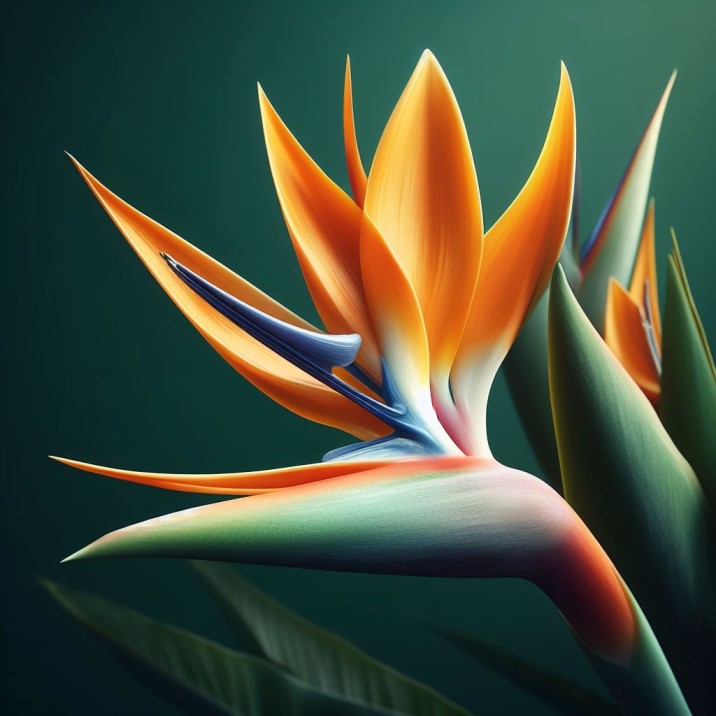
Flowering and Foliage
The stunning blooms and vivid foliage of Bird of-Paradise plants are well-known for them.
The vibrant orange, blue, or white blossoms, which resemble a tropical bird in flight, bring a splash of beauty to your room.
On the other hand, their impressively enormous and blue-green tropical leaves. These leaves assist to filter the air in addition to being aesthetically pleasing.
Overwintering
Your Bird plant will have a cozy winter vacation if you overwinter it. Move it indoors to a warm, well-lit area when the weather grows cooler.
Continue watering, but don’t overdo it; in between sips, let the soil air out a little. Remove any leaves that appear sad.
Common Pests
There are a few frequent insect issues that bird-of paradise plants may encounter, but don’t worry solving them is doable.
Watch out for mealybugs, spider mites, and aphids. Your plant may become infested by these microscopic creatures, which would harm the leaves.
Use insecticidal soap or gently wipe the afflicted leaves with a moist cloth to get rid of them.
Maintaining your Bird of-Paradise’s health and keeping pests at bay may be done with routine checks and prompt action.
Plant Diseases
- Leaf Spot: On leaves, it results in brown patches. Prevent by refraining from watering the leaves.
- Root Rot: When the roots receive too much water, this occurs. Use soil that drains properly and water your plant sparingly.
- Powdery Mildew: Like a white powder that is on the leaves. Maintain a healthy airflow around your plant.
- Pests: Your plant may be bothered by insects like mealybugs and aphids. Use soapy water or insecticidal soap to carefully remove them.
How to Get Bloom
- The process of getting your plant to blossom is satisfying. What you need to do to promote those lovely blossoms is as follows:
- Give it plenty of direct, bright sunshine.
- Maintain it at a warm temperature, ideally about 70°F (21°C).
- Have patience; these plants require time and may not blossom for some time.
- Pruning: Get rid of the faded blooms and dead leaves.
- Use a balanced fertilizer during the growth season to fertilize the soil.
- Avoid Stress: Try to move it about as little as possible.
Problems and Solutions
Problem: Yellowing Leaves
Solution: The plant enjoys somewhat dry soil between watering, so check your watering schedule. Make sure there is enough drainage, and prevent over watering.
Problem: No Blooms
Solution: 6 hours per day of enough sunshine is required. Be patient; immature plants may not blossom for several years.
Problem: Brown Leaf Tips
Solution: Maintain humidity and periodically spray the foliage. To keep your plant looking healthy, trim the brown tips.
Problem: Pests
Solution:Check your plant frequently for insects like aphids or spider mites. To get rid of pests, use neem oil or a mild insecticidal soap.
Problem: Root Rot
Solution: Maintain proper drainage and avoid overwatering. If required, repot in a soil that drains well.
Toxicity of Bird of Paradise
Pets who consume Bird of-Paradise plants may become poisonous. Their leaves contain substances that can make cats and dogs slobber and experience intestinal problems.
Put the plant out of your pets’ reach or think about picking pet-friendly houseplants if you want to keep them safe.
Even though Bird-of Paradise plants have a beautiful appearance, you should exercise caution if you have curious animal companions around to avoid any potential health risks.
Pets
Bird of-Paradise plants may be a lovely addition to your house, but if you have animals, particularly cats and dogs, they might not be the greatest choice.
If consumed, these plants can be harmful to our animal pets. To guarantee the safety and wellbeing of your dogs, it is imperative to keep them out of reach.
If you have pets, you might want to think about different non-toxic plant selections for your house in order to protect your precious creatures from any potential harm.
Bird of Paradise Appearance
This plant has magnificent, enormous leaves that resemble banana plants and are often blue-green in hue.
These leaves have a potential height range of 3 to 8 feet. It produces vivid, exotic-looking flowers in hues of orange, blue, or white when it blooms.
The name of the plant comes from how these blossoms resemble the head of a tropical bird. Overall, it’s a beautiful plant with distinctive, bird-like blooms and eye-catching leaves.
Varieties/Types
- Giant Bird-of Paradise (Strelitzia nicolai):
- Known for its large, banana-like leaves.
- Grows up to 30 feet tall outdoors.
- White Bird of-Paradise (Strelitzia alba):
- Features white and blue flowers.
- Slightly smaller in size compared to the Giant variety.
- Dwarf Bird-of Paradise (Strelitzia reginae ‘Dwarf’):
- Compact version, suitable for smaller spaces.
- Retains the classic orange and blue flowers.
- Mexican Bird of-Paradise (Caesalpinia gilliesii):
- Not a true Strelitzia but resembles one.
- Yellow, bird-like flowers and finely divided leaves.
Suggested Uses
Indoor Decor: With its eye-catching leaves and brilliant blossoms, decorate your house or place of business.
Use in tropical garden designs or as a focal point in outdoor landscaping.
Plant rows together to make a lush green wall for privacy.
Poolside Beauty: Give pool areas a hint of the tropics.
Cut flowers: Gather the enduring blooms to create gorgeous floral arrangements.
Air Purification: Take use of its air-purifying properties inside.
Large inside containers or patios are perfect places for potted plants.
Tropical Vibes: Give your room a vacation-like feel.
Symbolism: Use flower arrangements to symbolise pleasure and freedom.
Plant Care: Tips for Thriving Indoors and Outdoors
Caring for a bird of-paradise plant, whether it’s grown indoors or outdoors, requires attention to several key factors. When cultivating this striking plant indoors, ensure it receives ample sunlight, preferably near a bright window. Adequate sunlight is essential for its growth and the likelihood of blooming.
Be cautious of your bird-of paradise’s water requirements; it’s best to allow the soil to partially dry out between watering to prevent issues like leaves curling or turning brown. If your indoor plant isn’t blooming as expected, consider its exposure to sunlight and moisture levels.
Ensuring Pet Safety: Bird-of Paradise Plants and Their Toxicity to Cats and Dogs
For those with feline companions, it’s crucial to know whether bird-of paradise plants are safe for cats. These plants can be toxic to cats, so it’s best to keep them out of reach or opt for non-toxic alternatives like artificial bird of -aradise plants.
On the other hand, if you’re seeking a specific variety, such as the white bird of-paradise or the dwarf bird of-paradise, it’s essential to understand any potential risks they may pose to your pets.
Always prioritize the health and safety of your plants and animals when introducing new additions to your home or garden.
FAQs
What kind of light is ideal for Bird of Paradise plants?
This plants thrive with bright indirect to full sun exposure.
How should you manage watering for Bird of Paradise during the growing season?
Keep the soil consistently moist but allow it to slightly dry between waterings.
What should you do with watering during the winter months?
Reduce watering in the winter because the plant requires less moisture.
Why is it essential to maintain humidity levels for Bird of Paradise, especially indoors?
Humidity helps the plant thrive, and you can achieve this by misting the leaves regularly or using a humidifier.
How can you encourage new growth and maintain the appearance of Bird of Paradise?
Regularly prune dead leaves and spent flowers.
What type of soil is best for Bird of Paradise, and how can you achieve proper drainage?
The best soil is well-draining soil, which you may get by using a potting mix made for tropical plants or by adding perlite to common potting soil.
What temperature range do Bird of Paradise plants prefer when grown indoors?
This plants thrive indoors at temperatures around 65-70°F (18-24°C).
How can you propagate Bird of Paradise plants, and what are some common methods?
this propagate can be propagated through division, seeds, or rhizome cuttings.


